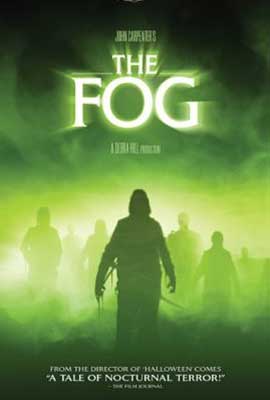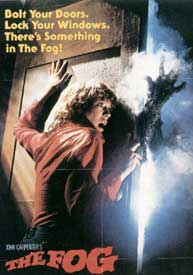 John Carpenter & Debra Hill's The Fog (1980) is one of the great gems of the horror genre. The widescreen anamorphic camerawork makes it look like a big budget film, though it was quite the opposite. This cinematography captures coastal vistas, gorgeous & haunting even before weird things happen. John Carpenter & Debra Hill's The Fog (1980) is one of the great gems of the horror genre. The widescreen anamorphic camerawork makes it look like a big budget film, though it was quite the opposite. This cinematography captures coastal vistas, gorgeous & haunting even before weird things happen.
And the cast is quite simply tremendous. The story opens with John Houseman's storytelling character of Captain Machen (named for mystic horror writer Arthur Machen) telling a tale of the haunted fog to wide-eyed children around a campfire. He is so beautiful in the firelight, & so serious of demeanor, that a rustic classy mood is instantly established.
Adrienne Barbeau is Stevie Waye, the sexy midnight radio voice, whose station broadcasts from the Spivey lighthouse. With minimal interaction with the rest of the cast, she almost functions as Greek chorus commentary. Eventually she delivers an action-climax on the roof of the lighthouse that was to emblemize strong women in horror films forever after.
Jamie Lee Curtis is Elizabeth the mysterious, rather erotic hitchhiker who arrives in town to instantly bond with the leading man (Tom Atkins), who she identifies as her Thirteenth Ride. The mystery of her character is a tease, & nowhere does the film quite inform us why she bears the same name as the ghost ship.
Hal Holbrook is Father Malone, the alcoholic priest who finds the coastal village's lurid history in a chronicle hidden behind masonry. He's a frightened man, which makes his final heroic act all the more nobly powerful.
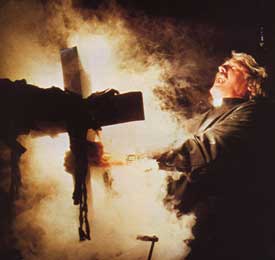 Father Malone is the grandson of the sixth conspirator among the town's founders, who were responsible for the destruction of the Elizabeth Dane & the drowning of the lepers on board. Father Malone is the grandson of the sixth conspirator among the town's founders, who were responsible for the destruction of the Elizabeth Dane & the drowning of the lepers on board.
The founder of the leper colony, a man of some wealth, had gold on board, & exactly one century after the cruel event, the sodden leper-ghosts are back to reclaim their lost colony's gold & avenge themselves on the descendants of the six conspirators.
The film does have some imperfections, but nothing that harms. The first few poltergeist activities in the town are a mite goofy, like car lights coming on & horns honking in parking lots. But when the glowy fogbank finally arrives, it's nonstop suspense & thrilling horror.
The ghost ship Elizabeth Dane takes its first victims on Arkham Reef beyond Spivey Point, & regular horror fans will delight at the reef's name (even though we know that Lovecraft's mythic town of Arkham is in Maine, not northern California).
The ship of ghost-lepers, enclosed in fog, arrives at Spivey Point, & the lepers disembark & rampage through town within the crawling mist.
There are some grisly moments & gore FX, yet the initial mood of classic weirdness instead of grossness is somehow never broken. It's amazing how the film manages to have it both ways -- gore FX in a context that retains atmospheric artistry.
I first saw The Fog in a drive-in during its first run, when I was quite young. It impressed me hugely & stuck in memory as a brilliant work of horror. Sometimes films revisited from the 70s or 80s don't hold up, or if they do hold up, costume & make-up fashions have so changed that the characters look severely dated. The Fog however has a timeless look to it, in character design & set design, just as it tells a timeless ghost story.
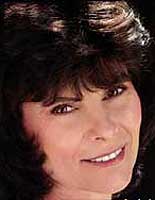 Among the extras on the dvd are two half-hour documentaries of a certain merit. Tales from the Mist: Inside 'The Fog' (2002) is an updating documentary with interviews & commentary that easily hold the attention of anyone who likes this movie. We get candid comments from Adrienne Barbeau, John Carpenter, John Houseman, Janet Leigh & others, including the late Debra Hill. Among the extras on the dvd are two half-hour documentaries of a certain merit. Tales from the Mist: Inside 'The Fog' (2002) is an updating documentary with interviews & commentary that easily hold the attention of anyone who likes this movie. We get candid comments from Adrienne Barbeau, John Carpenter, John Houseman, Janet Leigh & others, including the late Debra Hill.
A great deal is revealed about the process of making The Fog entirely distinct from Carpenter & Hill's first huge success, Halloween (1978). That the majority of the most memorable scenes were afterthoughts to spice up a failed first edit was especially surprising to learn.
Fear on Film: Inside 'The Fog' (1980), made contemporary to the original film release, provides quite a different perspective from some of the same people (Adrienne Barbeau, Jamie Lee Curtis & her mom Janet Leigh, Carpenter & Hill).
The older piece, filmed when no one knew what a classic The Fog would turn out to be, shows a depth of pride from everyone involved in the project. The newer piece with historical perspective confirms the justification for that pride. The two documentaries viewed in tandem add up to more than their separate parts.
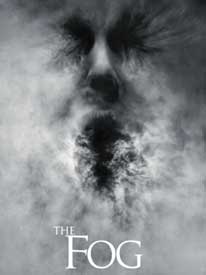 A 2005 remake of The Fog would seem particularly unnecessary since the original holds up so well & does not call for an "update." The FX of the original were great on a shoestring. Modern CGI makes it easier to get it done, but clearly not easier to get it done right. A 2005 remake of The Fog would seem particularly unnecessary since the original holds up so well & does not call for an "update." The FX of the original were great on a shoestring. Modern CGI makes it easier to get it done, but clearly not easier to get it done right.
Although on the one hand it's unfair to constantly compare a remake to a classic that has already withstood the test of time, on the other hand the most interesting bits in the newer film are referential to the original. I suspect that anyone unfamiliar with the original would find the remake even less interesting because they'd miss the referentiality & would focus more on how uninteresting the cast manages to be for the entire first hour of the story, how poor the editing & pacing, & how uneven the FX.
One thing I enjoyed was the greater understanding of the character of Elizabeth. In the original, we wonder why the ghost-ship the Elizabeth Dane & Jamie Lee Curtis's character share a first name. At one point she acknowledges that the town's problems began the hour of her arrival as a hitchhiker. Nowhere in the film was this developed, however, so it is left hanging as a coincidence.
The remake makes it obvious that one of the lepers murdered a century before was a woman named Elizabeth, & the modern-day Elizabeth is in fact her incarnation. That the explanation turns out to involve a fairly lame love story developed primarily in the special FX department rather than in the skill of the actors makes this new & novel revelation ultimately pretty boring, but it was at least interesting how the updating screenwriter picked up hints in the Carpenter/Hill script & followed them up in the re-do.
That she was reincarnated might also infer that the conspiring killers from a century before were incarnations, & the ghosts weren't avenging themselves on innocent descendants, but on the original killers in their later lives. The present film doesn't suggest it, though, as no one was thinking quite that far along in this reincarnation routine.
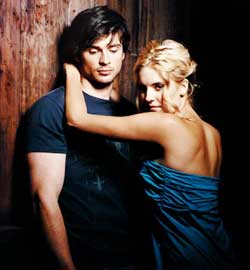 The first hour of the remake is particularly poor because of the comparatively less interesting actors, selected for youth appeal rather than for ability to create intriguing & believable characterizations. Even drunken Father Malone is a young dude in the remake. The first hour of the remake is particularly poor because of the comparatively less interesting actors, selected for youth appeal rather than for ability to create intriguing & believable characterizations. Even drunken Father Malone is a young dude in the remake.
There's an attempt to improve the "preliminary" weird occurrences which in the original film consisted of inexplicably honking car horns & blinky lights. In the remake the preliminaries become such events as the fog cooking a dog. But as no character of importance was attached to any of these events, they don't have much power.
Nor is there much attempt to be internally logical. There's a lot of electrical & electronic equipment on board the Seagrass which blows up, yet the ship works fine the next day even with everything broken, & it turns out a digital video camera had been on the whole time & recorded what happened.
So the fog selectively destroys stuff, leaving intact whatever is required by the script. When all the equipment in the weather station is similarly destroyed, the computer still works, an inconsistency explained as due to the laptop having its own battery, & the phones still work I guess because they're not part of the electrical wiring -- though really it's just so Stevie in her lighthouse with her laptop's newly installed camera-phone can watch what happens to the weatherman from afar. It's all just movie patness, & reduces the events to a carnival ride.
Now that we know that stuff that works on batteries (like the computers & that digital video on the Seagrass) is unaffected by the fog, we can see also why cars continue to work, since they run on gasoline & batteries --- uhhhh, just like the Seagrass did. But then for decorative effect some cars are shown bursting into flame. Still, when the main characters need transportation from location to location to keep the action going, the fog does not affect their cars.
I suppose it's asking way too much that in a film where impossible things can happen, that they happen with at least a slight degree of consistency.
For a while during the film I realized the most fun part was watching for the inconsistencies & mistakes. Like when a guy goes down to the beach with a metal detector, when he detects something in the sand, he has to fall on his knees & dig it out with his bare hands. I've seen a lot of old coots with metal-detectors on the beach, & not a one did all his digging with his bare hands.
Or, failing to do any research on how 19th Century leper colonies came about, the ignorant script posits that the Chinese brought the leprosy plague to a healthy island colony & the disease went rampant killing half the inhabitants & leaving the other half disfigured. In reality Hanson's disease does not spread easily under any circumstance. Leper colonies came about because victims of leprosy were shipped off to just such isolated locations. But hey, if you can blame the Chinese, do.
At the 66th minute of boring film time the fog finally arrives in town. Since the cast could not duplicate the captivating performances of the 1980 cast, we can at least hope that with a budget something like thirty-five times larger for the remake, & advances in FX technologies in the intervening decades, we'll at least have an FX fun-ride in the end.
Turns out the FX are a mixed bag, most ordinary, some terrible, a couple really good. Throughout, characters don't matter, acting doesn't matter, story barely matters. The original's ghostly message "Six must die" becomes in the remake "Blood for blood" so that a greater number of kill-gags can be done. The one good choice was to show a great deal more about what initially happened to the lepers in the 1860s, but nothing else is an improvement.
Since FX are the remake's sole claim to delivering a full entertainment quotient, let's grade this plethora of bonus FX:
- Hairbrush bursts into flame: D-
- Weatherman turns into burning skeleton: D+
- Guy on beech pulls on rope & gets sucked out to sea: D-
- Fog makes Stevie crash into the sea encountering water ghost: B-
- Andy sees screaming fog-face: C
- Nick drives right through dirty fog ghost: B
- Leper ghosts dressed in Grateful Dead top-hats but none fat enough to be Jerry Garcia himself: C+
- Leper ghost reaches arm out of sink drain: F
- Followed by old lady who was doing dishes rotting instantly: B
- Flashback of burning of the Elizabeth Dane: A
- Rotting away of statues & portraits of town founders: D-
- Woman sucked out window: C+
- Skullface version of Blake kills Father Malone with glass shards: C
- Blake uses force-field to "roll" somebody down the street: B
- See-through ghosts standing in cemetery: C+
- Contract catches guy ablaze for standard fire gag: F
- Elizabeth reunited with see-through kissy ghost: C-
- Elizabeth turns into leper ghost, saving town: B-
copyright © by Paghat the Ratgirl
|
